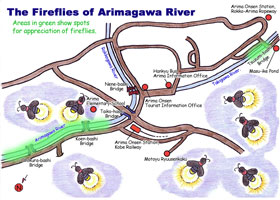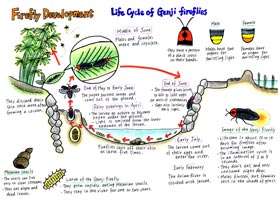The Fireflies of Arimagawa River
The beautiful scenery of the early summer at Arima Onsen would have to be the emergence of the Sal Tree flowers at Nenbutsuji Temple and the fireflies ("hotaru" in Japanese) of Arimagawa River. For one month, swarms of fireflies amass at Arimagawa River at the end of May and truly fantastical scenes of illumination are visible at night as the fireflies flutter along the riverbanks until the end of June. Should you have a chance to visit Arima Onsen during this season, we heartily recommend that you come out to appreciate the beauty of this natural spectacle.



Some dozen years have passed since the Arima Elementary School began striving
for an "Arima Onsen that is kind to people and a firefly elementary
school." In cooperation with the Recycle Promotion Section of the
Kobe City Environmental Bureau, the student council, and the Arima Onsen
Tourism Association, the entire school body became involved in the breeding
and stocking of fireflies in 1991 with the motto of "Let's beckon
a return of the fireflies to Arima."



£Click here to enlarge the map.£
Two popular sightseeing spots near the Arima Onsen Station of the Rokko-Arima
Ropeway are Tsuzumigataki Waterfall and Masu-ike Pond. The river flowing
from the waterfall is called Takigawa River. Here the river runs into the
Rokkogawa River near Nene-bashi Bridge, and this forms Arimagawa River.
Passing beneath the Taiko-hashi Bridge near the Arima Onsen Station of
the Kobe Railway, Arimagawa River flows under the Koen-bashi Bridge, which
is near the Arima Elementary School, and the Otokura-bashi Bridge, which
is further downstream. It continues along going north until it finally
joins the upper parts of the Mukogawa River.
Those visiting Arima Onsen with the intention of appreciating the beauty of the fireflies can enjoy the sight of them at night on the riverbanks downstream from the Masu-ike Pond on Takigawa River and the area spanning from Koen-bashi Bridge to the Otokura-bashi Bridge.





Etiquette for Appreciating Fireflies
- Fireflies detest light, so be sure to turn off your car lights.
- It is better to avoid creating loud noises and be quiet.
- Although fireflies are not afraid of humans and will fly near us, let's not catch them and take them home with us.
- Let's not leave cigarettes or any trash behind.


Habitat
Fireflies can live anywhere near a river if the water is clean and not polluted by agricultural pesticides or synthetic detergent.
Types of Species
Around 2,000 species of fireflies can be found all over the world with 40 types found in Japan. Of the fireflies seen in Japan, the most common are the three types described below. The type of firefly commonly seen at Arimagawa River is the Genji Firefly (Luciola cruciata Motschulsky).
Comparison of the Three Types
| Type | Genji Firefly
(Luciola cruciata Motschulsky) | Heike Firefly
(Luciola lateralis Motschulsky) | Hime Firefly
(Luciola parvula Kiesenwetter) |
| Photograph |  |  |  |
| Body length | 10-20mm | 10-18mm | 5mm |
| Illumination cycle | 2 second intervals | 1 second intervals | 0.5 second intervals |
| Luminescent-color | Yellow | Yellow | Rose pink |
| Habitat | Small clean river, irrigation channel | Rice paddy, irrigation channel, small clean river | Cedar, white cedar forest, etc. |
| Food for larva | Melanian snail | Sinotaia quadrata histrica (pond snail), Austropeplea ollula (Japanese ear snail), Physa acuta, etc. | Allopeas clavulinum Kyotoense, Clausiliidae, etc. |
| Appearance (in general) | Beginning of June to the end of June | Middle of June through the early part of July | Early June to late July |
| Number of eggs | 400-1000 eggs | 70-100 eggs | 50-100 eggs |
Life Expectancy
Lifetime is about 10-14 days for both males and female after becoming imago (adult firefly).
Mode of Life

£Click here to enlarge "Firefly Development".£
Fireflies cast off their skin as larva five times, go ashore, and cast off their skin once more after forming a cocoon. They spend nine months as larva on the river, go ashore in April when it rains, and make a cocoon in the ground. They become pupa and emerge around fifty days later. When they become imago (adult firefly), they don't eat and only come out at night.
Chance for Appreciation
Genji fireflies can often be seen on dark, cloudy, sultry evenings but are not active when temperatures drop. Peak times for these fireflies are 8:00-9:00 pm or in the dead of night from 12:00-1:00 am or 3:00-4:00 am.



The fantastical illumination emitted by fireflies involves the same mechanism for light as found in the oxidation reaction of a burning candle.
In the luminescent organ of the firefly, there is a luminous substance called luciferin that reacts to oxygen in the air to emit light.
Usually oxidation at the time of a reaction emits heat and light, but the enzyme luciferase within the luminescent organ of the firefly efficiently oxidizes without expending a great deal of energy and changes to light.
Furthermore the faint glow of light and darkness is linked to breathing. When it breathes, the membrane blocking the light is lowered, and light is extinguished.



![]()










